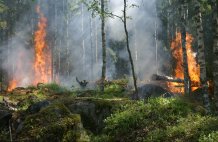Articles

The study suggests that unrestrained deforestation, converting rainforest to agricultural land, could expand the areas at risk of wildfires by more than 70 per cent by the end of the century.
Sustainable land management key to reducing Amazon wildfires, study shows
The unrelenting deforestation of the Amazon region could lead to a dramatic increase to the risk of destructive wildfire outbreaks, research has shown.
The new study suggests that unrestrained deforestation, converting rainforest to agricultural land, could expand the areas at risk of wildfires by more than 70 per cent by the end of the century.
In response, the international team of researchers, including Dr Luiz Aragão from the University of Exeter, suggest that concerted efforts to improve sustainable land management in the area could provide the best method of defence over the coming decades.
The study is published in the prestigious journal Global Change Biology.
The research team, led by the National Institute of Space Research (INPE) and the Centre for Disaster Research and Monitoring (CEMADEN) in Brazil and also including Stockholm University, used sophisticated modelling techniques to conduct the study.
It showed that policies such as the construction and paving of new highways, increased deforestation and reducing the effectiveness of protected areas could dramatically increase the risk of wildfires.
Crucially, when coupled with the IPCC´s CMIP5 pessimistic climate change scenario, which projects increased greenhouse gas (GHG) emissions throughout the 21st century, the area with high probability of wildfires could increase by up to 110%.
Dr Aragão, who is also head of INPE's Remote Sensing Division, said: “The study identifies a very serious problem and we have to use this result for the benefit of Brazil’s sustainable development
“For the first time, we have been able to demonstrate that although the climate is changing, with the possibility of negative consequences for the Amazon, the biggest villain on the burning issue is the poorly planned use of land in this region.
“The bottom line is that unlike the climate, land use issues can be addressed through control measures that can be implemented quickly, solving a significant fraction of the problem.”
According to the DETER/INPE deforestation alerts, between July 2018-2019, 5,364 km2 of forests – an area the size of the island of Trinidad - were cleared, and another 4,405 km2 were affected forest fires.
Dr Marisa Fonseca, a postdoctoral researcher at INPE and lead author of the study said: “This means that if we continue removing forest cover in Amazonia, we will be potentializing wildfire degradation of the remaining forests, with consequences for the stability of carbon stocks and environmental services.”
Conservation units and indigenous lands may not be safe. The results from the model indicate that more than 1 million km2 within indigenous lands or protected areas would be subject to an increased likelihood of occurrence of wildfires, threatening both ecosystems and human populations in these areas.
The adoption of measures aimed at reducing deforestation and GHG emissions, however, can significantly reduce the probability of wildfires, even with the intensification of droughts in the Amazon by the end of the century.
The study, Effects of climate and land-use change scenarios on fire probability during the 21st century in the Brazilian Amazon, can be accessed here .
Date: 19 July 2019
